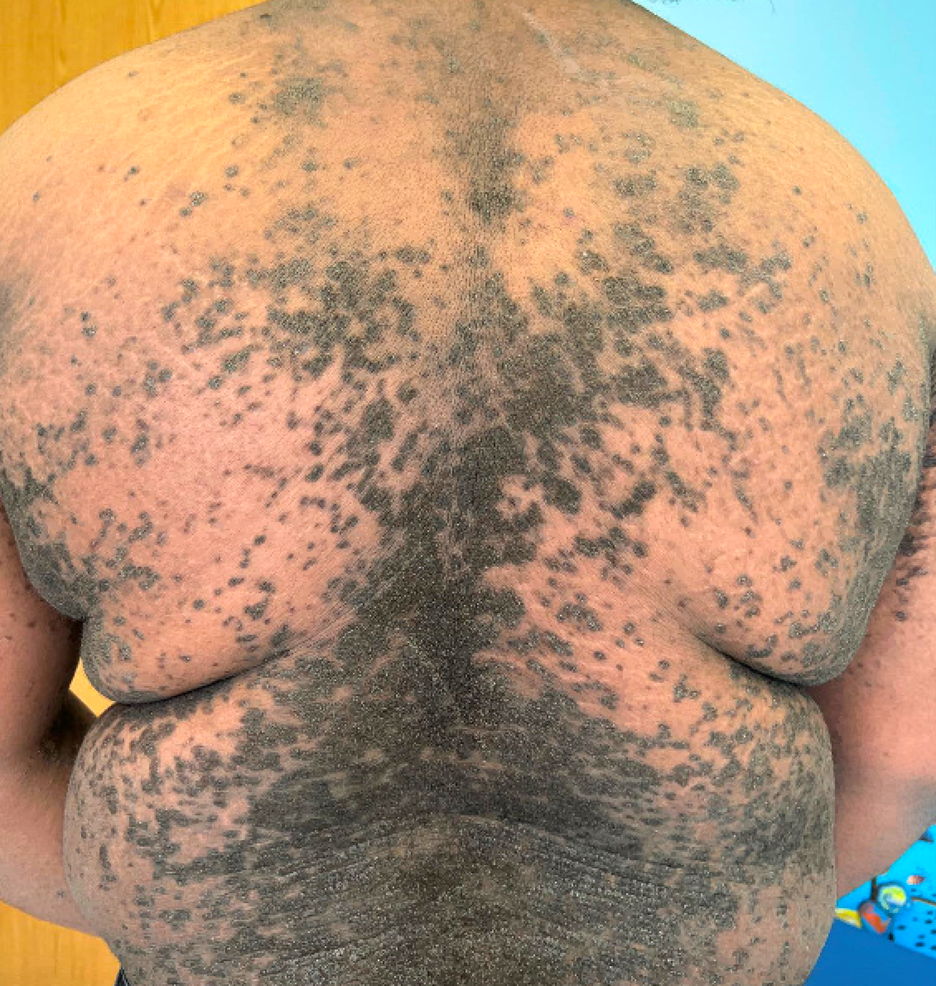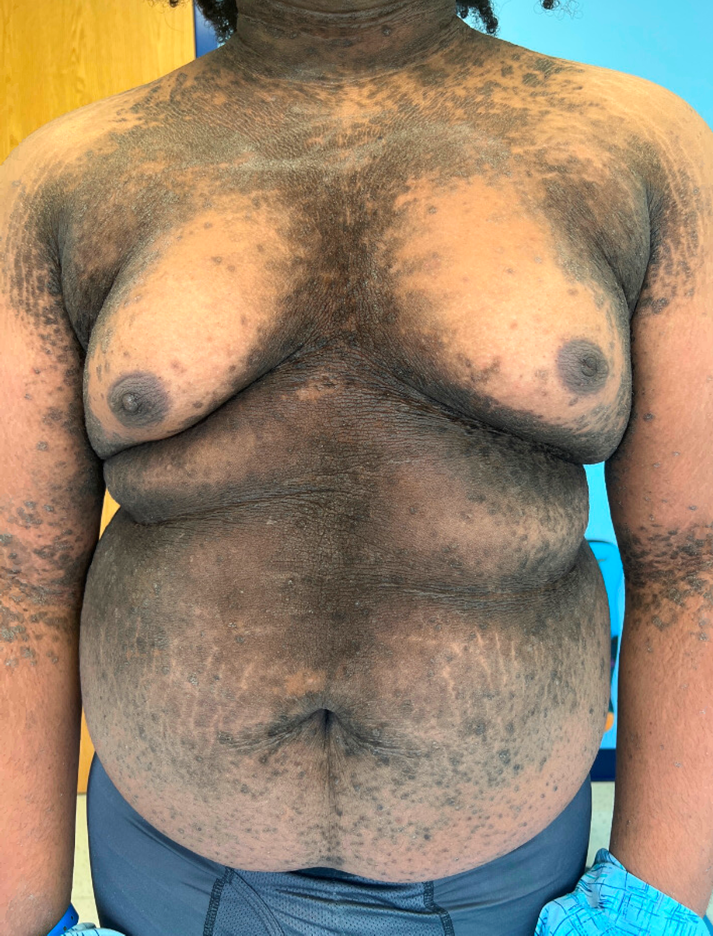Visual Diagnosis: What's the Diagnosis?
Column Author: Sean Reynolds, MBBCH | Associate Program Director, Pediatric Dermatology Fellowship
Column Editor: Angela L. Myers, MD, MPH | Division Director, Infectious Diseases; Medical Director, Center for Wellbeing
A 14-year-old male presented for evaluation of a rash. It started on his neck two years prior to presentation and has gradually spread to involve the chest, back, abdomen and arms. He was treated with topical ketoconazole shampoo for several weeks, and subsequently oral fluconazole, without improvement. At home, various treatments, including topical apple cider vinegar, hydrogen peroxide, and vigorous scrubbing, were attempted but proved ineffective.


What is the most likely diagnosis?
A) Acanthosis nigricans
B) Pityriasis rosea
C) Confluent and reticulated papillomatosis (CARP)
D) Tinea versicolor
E) Retention hyperkeratosis
C) Confluent and reticulated papillomatosis (CARP)
This adolescent male presents with a slowly progressive, chronic, and predominantly truncal eruption. Examination of the photographs reveals dark brown to black, slightly scaly, thin papules and plaques that coalesce in a reticulated pattern. The lesions at the periphery display a reticulated distribution, while those more centrally located are more confluent. Recognizing the reticulated nature of the peripheral lesions and their central coalescence is helpful in diagnosing CARP.
CARP is an underrecognized and often misdiagnosed eruption of unclear etiology. It is more common in patients with skin of color and may appear more pinkish in those with lighter skin types. Onset is typically around puberty. It occurs more than twice as frequently in females that males. It is most commonly asymptomatic but occasionally can be pruritic.
It is frequently misdiagnosed as tinea versicolor; however, tinea versicolor is not usually reticulated, which is a key feature of CARP. A KOH scraping of CARP will be negative but may demonstrate hyphal elements in patients with tinea versicolor.
Acanthosis nigricans can have an overlapping distribution to CARP and in fact can be a coexisting condition in these patients, possibly due to both conditions being associated with insulin resistance. However, acanthosis nigricans is not reticulated and is generally thicker, with more concentration in intertriginous areas and less truncal involvement compared to CARP.
Pityriasis rosea has a different distribution than CARP, with typically pink or hyperpigmented scaly ovoid papules and plaques oriented along the relaxed skin tension lines, which give the characteristic “Christmas tree” pattern of the dermatosis.
Retention hyperkeratosis is a common condition in which adherent scales form due to inadequate cleaning or exfoliation of the skin and are commonly seen on the neck and ankles. Retention hyperkeratosis is not reticulated and can be readily removed with vigorous rubbing with an alcohol swab, whereas CARP cannot.
Which of the following if the most appropriate treatment?
A) Doxycycline
B) Topical clindamycin
C) Topical triamcinolone
D) Oral prednisone
E) Oral fluconazole
A) Doxycycline
The etiology of CARP remains unclear. It is thought to be due to disordered keratinization given its histologic features and that it can respond to keratolytics and topical retinoids. As CARP has been frequently reported with concomitant acanthosis nigricans, insulin resistance, polycystic ovarian syndrome and diabetes mellitus, it is important to evaluate for signs and symptoms of these conditions in patients with CARP. In these cases corresponding improvement and worsening of CARP with changes in weight and glycemic control have been reported. However, the majority of patients with the condition are otherwise healthy.
While the underlying cause of CARP remains unclear, the first-line treatment is typically a tetracycline antibiotic, either doxycycline or minocycline. Doxycycline is increasingly favored due to concerns for toxicities with minocycline (such as drug-induced hypersensitivity syndrome, drug-induced lupus, and dyspigmentation). Treatment is generally administered for several weeks to months. Recurrence rates can be as high as 50%, at which point other oral antibiotics or topical agents (such as topical retinoids, topical calcineurin inhibitors and topical vitamin D analogues) may be considered.
References:
- Lim JH, Tey HL, Chong WS. Confluent and reticulated papillomatosis: diagnostic and treatment challenges. Clin Cosmet Investig Dermatol. 2016;9:217-223. PMID: 27601929. PMCID: PMC5003519. doi:10.2147/CCID.S92051
- Scheinfeld N. Confluent and reticulated papillomatosis: a review of the literature. Am J Clin Dermatol. 2006;7(5):305-313. PMID: 17007541. doi:10.2165/00128071-200607050-00004
- Banjar TA, Abdulwahab RA, Al Hawsawi KA. Confluent and reticulated papillomatosis of Gougerot and Carteaud: a case report and review of the literature. Cureus. 2022;14(4):e24557. PMID: 35651451. PMCID: PMC9138193. doi:10.7759/cureus.24557
- Davis MD, Weenig RH, Camilleri MJ. Confluent and reticulate papillomatosis (Gougerot-Carteaud syndrome): a minocycline-responsive dermatosis without evidence for yeast in pathogenesis. A study of 39 patients and a proposal of diagnostic criteria. Br J Dermatol. 2006;154(2):287-93. PMID: 16433798. doi:10.1111/j.1365-2133.2005.06955.x
